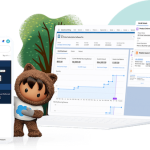This post was updated in August 2022.
MuleSoft has been part of the Salesforce family for more than two years. During that time, we’ve been helping companies achieve digital transformation by easily connecting all their business systems. So, what does MuleSoft do? Let’s explore the powerful world of integration.
IT innovation takes on a new urgency
Over the last few years, organisations relied on IT to support a rapid shift to remote working. Day-to-day operational demands have always taken up too much of IT’s time, especially during the COVID-19 pandemic period. As businesses gradually move toward hybrid working, the number of systems and amount of data that companies need to manage has increased. This creates an integration barrier to automation progress which 96% of companies find it difficult to overcome.
According to the 2022 Connectivity Benchmark report, organisations asked IT, on average, to deliver on 40% more projects over the last 12 months. Organisations are increasing IT budgets (5.8% in 2021), but not in line with the growing demands from the business. This is contributing to a widening IT delivery gap for many companies.
At the same time, many organisations are accelerating digital transformation. Digital transformation is no longer seen as an option, but a necessity. Customers expect fast, digital, and on-demand experiences, or they will take their business elsewhere.
The more digital transformation initiatives that need to be implemented, the wider the delivery gap gets. It’s a balance most organisations still struggle to find. The central pillar to solve this huge challenge is to understand how integration drives digital transformation.
MuleSoft automation addresses those concerns with capabilities that allow customers to automate any process for any team. Enter MuleSoft.
So, what does MuleSoft do?
Customers expect connected experiences. They don’t want to see the seams where your systems and departments meet.
MuleSoft brings a new unified solution for automation, integration, and Application Programming Interfaces (APIs) that easily automates any workflow and system for your team. It helps your team to quickly adapt to constant change and business complexity. This makes it easy to consolidate data to deliver a single view of the customer to build connected experiences.
The solution now includes no-code capabilities to automate repetitive manual tasks using bots with MuleSoft RPA (robotic process automation). It can quickly connect data from any system, such as Slack with MuleSoft Composer. The new capabilities are fully integrated into Salesforce Flow, a comprehensive suite of automation technologies across the Customer 360 to increase efficiency and productivity and deliver unparalleled experiences.
This expanded MuleSoft capabilities facilitate co-creation and accelerate innovation across IT and business teams. Business teams such as sales can close deals more efficiently and service reps can quickly sync customer records to improve customer service interactions.
The results speak for themselves. Salesforce customers are creating 4.8 billion MuleSoft transactions daily and this saves over 100 billion hours of work every month with Salesforce Flow. Forrester found that MuleSoft customers realise an ROI of 445% within just three years and were able to free up 90% of developer time from maintaining APIs and integrations.
MuleSoft case study
Let’s use an example. One of the world’s largest consumer goods providers wanted to find more efficient solutions to deploy new products and services. Their goal was to roll out a new ecommerce initiative quickly, to engage directly with customers through both digital and in-store channels, and deliver a better customer experience. However, delivering end-to-end automation is broader than what their IT team can handle on its own.
To make this happen, IT and business teams need to work together to facilitate the change as multiple tools to its ecommerce platform, such as Salesforce Commerce Cloud, SAP, and NetSuite need to be integrated. Using a custom code path, the IT teams would need to:
- Spend IT time, effort, and resources to build three separate integrations while also including security considerations.
- Hire an employee who understood the thousands of fields in their enterprise resource planning (ERP) system, the various systems required for their new ecommerce platform, and was able to build each integration.
- Create additional integrations if they ever change any of the systems they use.
- Spend time and effort on training the other teams to use the various systems.
Instead, the company decided to adopt MuleSoft to enable the connectivity between tools and collaboration between teams. Using MuleSoft RPA, the company started by building an automation platform that connects with Anypoint Platform and Composer to eliminate manual tasks and processes. MuleSoft RPA takes only the information needed from the relevant systems, combines it, and exposes it in a simple and accessible format. That means:
- Repetitive and manual tasks can be replaced with bots that can intelligently process data from any system, document, photo, or legacy user interface. These bots can also be securely shared and reused across teams.
- Applications with pre-build enterprise connectors and bots can be seamlessly integrated with both MuleSoft Composer and MuleSoft RPA.
- Automations can benefit from hundreds of connectors to important systems and even directly call APIs created by technical teams.
- Teams can use MuleSoft RPA to automate workflows across multiple systems and apps by integrating RPA bots seamlessly with Salesforce Customer 360, Anypoint Platform, and MuleSoft Composer.
- IT teams can govern, monitor, and secure any automation and integration built with APIs or bots with Anypoint Platform.
In other words, business teams can gain productivity instantly with no-code automation, and leadership teams can immediately start to create and reuse composable assets to transform business. Thanks to MuleSoft, the IT and business teams are now working together on one platform to deliver unparalleled customer experiences. Today, deployment for new initiatives is 3-4 times faster — dropping from months to days.
How Salesforce and MuleSoft can be leveraged together
MuleSoft can connect any system, application, data, and device to unleash the power of Customer 360. The combined power of MuleSoft, the #1 integration platform, and Salesforce, the #1 CRM, enables customers to accelerate digital transformation.
Together, MuleSoft and Salesforce give companies the ability to unlock data across systems, develop scalable integration frameworks, and ultimately create differentiated, connected experiences at a rapid pace. Across various integration patterns, Salesforce products, and third-party systems — the integration possibilities are endless. These include developing integrated applications with Lightning Platform, Heroku, Slack, and Tableau to achieve a single customer view in Sales Cloud and Service Cloud. By incorporating siloed third-party systems, and connecting Salesforce Customer 360 with legacy sources to synchronise order, invoice, and product information. With MuleSoft, repetitive work can be eliminated and that helps to increase employees’ productivity and reduce costs for customers.
Learn more about how MuleSoft RPA automate repetitive processes and tasks for your business.
Gain insights into the enterprise technological trends from IT leaders worldwide.

























